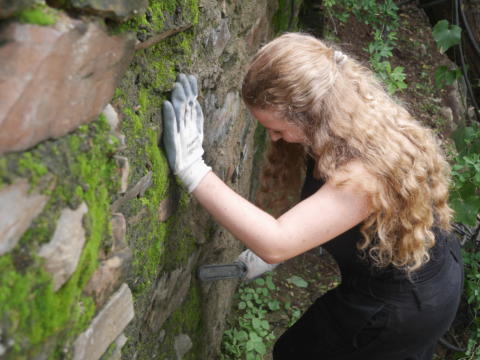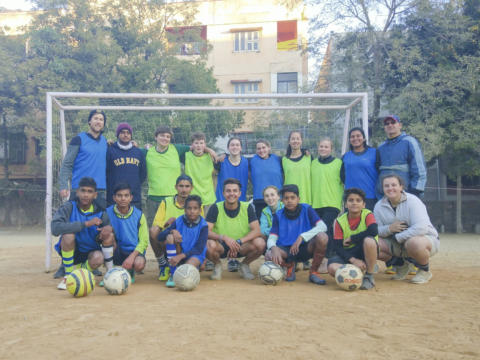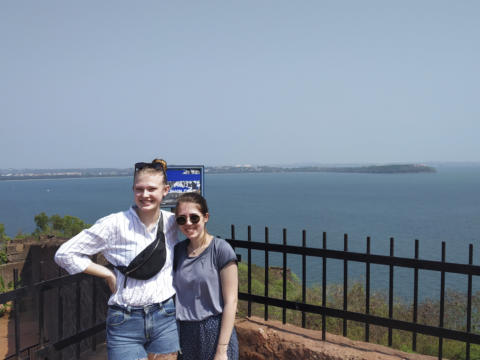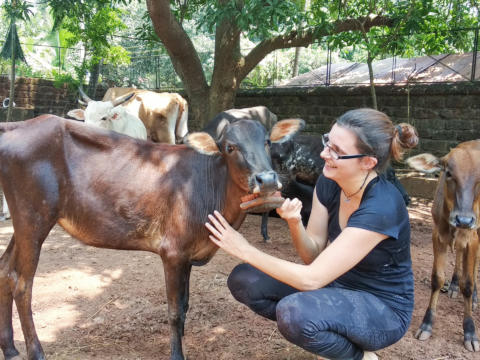Only 360€ per week!
Kindergarten and Teaching
Goa - India
Embark on a journey into Goa to assist in teaching to the migratory slum children who attend our school in the remote villages of Goa.
The school teaches various educative subjects to migrant slum children from underprivileged backgrounds. On this program, you will have the opportunity to teach the children, teach hygiene and sanitation knowledge and help in organizing educative workshops on various need-based aspects such as sports, arts, health awareness, environment, etc.
Program Description
This project is mainly conducted for children in the age group of 3-16 years belonging to migrant families living in slums located on the periphery of the city.
Our indoor and outdoor school was established because of the population of migrant labourers are increasing day by day, which has been the situation in Goa since the last few years. The direct negative impact of this migrant situation has effected children who are in their schooling age. They have to drop out of their schools for 4-5 months every year as their families migrate to different locations every few months.
Most of the migrants are from far away regions of Southern & Northern India (eg., Uttar Pradesh, Maharashtra, Karnataka, Madhya Pradesh, Bihar, Kolkata etc). This migrant community sets up camps on the outskirts of cities and live there for almost a year depending on the various odd jobs they can find. The longer they stay back, the longer the children do not get the opportunity to go to school. And the children end up working at a very tender age to gain extra income for their families. Therefore, the main objective of this project is to encourage these migrant children to focus on their education by giving them the opportunity to continue their learning with us.
Despite the fact that there is a public school already in the vicinity, it has not helped the education of the children in the migrant communities for various reasons such as,
● The community’s understanding that education is less important
● The distance to the school (5km), where the children find it difficult to walk as there are no local transportation provided by the public school
● Financial constraints
● The migratory tradition of the community
To overcome these issues and to make education accessible to these underprivileged population, we have come up with an alternative and have taken the initiative to run a community school at the village, where the education is free of cost and the school is at a walking distance from their homes.
Our main concern is the realization of sustainable peace and development in which the children, youth, women, adults, and elders are involved in positive activities that will ensure socio-economic welfare in this village. The vision is to educate and inspire the younger generation who are not fortunate enough to be trained or even to go to school because of their backgrounds.
Activities at the School:
You will be involved in various activities such as
- Provide regular basic education for migrated children in the age group of 5 to 14
- Develop infrastructure in the village such as better access roads, build toilets, construct a rainwater harvesting system, and setting up libraries
- Conduct workshops and training to make kitchen gardens, teaching health, hygiene habits and nutrition
- Conduct environmental camps to spread the awareness of household waste management
- Classes for kindergarten children during the day as their parents go to work. Organizing summer camps during the summer vacations of April and May.
- Conduct sports coaching camps in football for the children of the community
Our outreach school educates underprivileged children from slums, whose parents cannot afford to send them to school. The teaching sessions take place in the mornings and afternoons where the participants interact with the children using games and activities to teach them and help them understand the importance of education and developing skills.
Aims & Objectives
To provide access to quality coaching, education and literature for the community at large.
Schedule
Monday
Orientation Tour in Goa
On your first day of the program, you will have an orientation, to better understand your new environment and program. Our coordinators will take you to an enchanting spice plantation, visit the local market, and a few supermarkets located close to our center. You can also utilize this time of the day to exchange your currency or purchase any of the essential items you might need during your stay.
Tuesday
Project Visit
On the second day of your first week, introduction to the local projects and program will be given through an observation time at the project site, you can also choose to assist as existing participants on the project. Our coordinator's will also theoretically orient and train you on the activities of the project and introduce you to your role in a step-by-step manner.
Wednesday
Your time on the project will commence on Wednesday.
08:30 to 12:00 – Kindergarten for the migrant slum children of ages between 4-6
Tasks and activities include,
● Teaching alphabets and numbers in English, three letter words, and forming sentences
● Making them color pictures and teach them the colors
● Teaching them to talk about themselves
● Teaching shapes, colors, animals
● Doing educational Games
From 14:30 to 17:00, join the education program for migrant slum children of all ages, mainly between 3-16 yrs. Today you will teach Art and Craft to the kids.
(The children are divided into 3 major groups as per their age, and studies are taken up as per the children’s age and understanding level.)
Thursday
09:30 to 12:00 – Kindergarten for the migrant slum children of ages between 4-6 Tasks and activities include,
- Teaching alphabets and numbers in English, three-letter words
- Making them color pictures and teach them the colors
- Teaching them to talk about themselves
- Teaching shapes, colors, animals
- Doing educational Games
From 14:30 to 17:00, join the education program for migrant slum children of all ages, mainly between 3-16 yrs. Today you will teach spoken English, Geography, General Knowledge, and Science, and world history to the kids.
- (The children are divided into 3 major groups as per their age, and studies are taken up as per the children’s age and understanding level.)
Friday
08:30 to 12:00 – Kindergarten for the migrant slum children of ages between 4-6
Tasks and activities include,
● Teaching alphabets and numbers in English, three-letter words
● Making them color pictures and teach them the colors
● Teaching them to talk about themselves
● Teaching shapes, colors, animals
● Doing educational Games
From 14:30 to 1700, join the education program for migrant slum children of all ages, mainly between 3-16 yrs. Today will be the day for sports activities. You will have the opportunity to teach games which are popular in your country.
(The children are divided into 3 major groups as per their age, and studies are taken up as per the children’s age and understanding level.)
Note: This schedule can be changed and/or amended depending on weather conditions, local conditions and unforeseen circumstances.
Note: This is a full-time project, you will not have the option to choose or combine with any other projects.
Participant Criteria & Requirements
Standard Requirements
Minimum age: 18
Maximum age: –
Minimum English level: Basic
CRB required: On Signup
Passport copy required: On Signup
Resume copy required: No
Required qualification: None
Additional Requirements
- Participants above the age of 65 should have medical clearance.
Additional Equipment
Dress Code
- Cover up as much as possible in the spirit of the local culture to avoid embarrassment.
- Your clothes must not be too short, too tight or too revealing. Kindly make sure your shoulders and legs are covered.
- Dress professionally since you will be working in a professional environment while teaching the children.
- It is completely fine to wear western clothes as long as they fit the local standards
- Be thoughtful of the graphics, symbols or text printed on your clothing and avoid wearing clothing styles that might be inappropriate
- Be thoughtful to poor communities by not displaying expensive items and clothes
- Wearing local clothes could help you build a good working relationship with the community
Location
Consistently ranked among India’s top tourist destinations, Goa is the ideal place for first-time travelers and adventurers alike to acclimatize to a different culture. From caves behind waterfalls to villages hidden in sandy coconut forests, there is always something more waiting to be rediscovered. The mountain ranges and spice plantations enhance the beauty of this glorious state. Apart from its natural beauty, this former capital of Portuguese India and home to various UNESCO World Heritage sites has a lot to offer in terms of architecture with churches, cathedrals and forts abounding. Put together, it is all of these aspects and more that make Goa the ultimate travel destination.
About the Accommodation
In our centre, there is a mini library, a dining room, a lounge area where you can hang out with fellow participants and a beautiful garden to relax.
Furthermore, there is a refrigerator which you are welcome to use to store food and beverages.
Food Arrangements
The meals are a mix of Western and Indian food, consisting mainly of vegetarian dishes including rice and vegetables. You can expect to have a chicken dish about twice per week. You can also use the kitchen facilities to cook for yourself or eat out at any of the local restaurants.
Facilities
ATMs: There are ATM's around our centres. The closest one to our residence is about a 15-minute walk from the house.
Shop: The closest local supermarket is a 15-minute walk from the centre.
Activities & Events
No scheduled activities outside the program.
Sights & Surroundings
Goa has a very long coastline with an almost unbroken sand cover. So, if you’ve come looking for sun, sand and sea without the crowds and the fuss you’ll be pleased to discover these beaches tucked away in quiet recesses where you can go to truly escape the world. Here is our list of secluded beaches to try during your Goa weekend getaways. You might have to take your own food and water as there are no eateries or accommodation near some of them. And though some of them may seem out of their way, you’ll be glad for the peace and quiet when you get there.
- Butterfly Beach
- Kakolem Beach
- Galjibag Beach
- Hollant Beach
- Betul Beach
- Arambol Beach
- Agonda Beach
- Cola Beach
- Velsao Beach
- Sinquerim Beach
- Siridao Beach
Goa has a pleasant climate all around the year. Monsoon season is from June to September which is the rainy season for Goa. Goa gets an average rainfall of 330 cm annually which is about 90% of its annual rainfall. This season also happens to be the favourite of the travellers coming to Goa with its various celebrations happening. And from October to March it gets a very pleasant climate with clear skies and nights being busy with the festivals and sky full of fireworks. Summer starts in April and the long sandy beaches and the sunshine are so welcoming.
Transportation
From this location we do not provide free transport to other locations.
Quick Facts
Name: Republic of India (Bhārat Gaṇarājya)
Population: 1.252 billion
Capital: New Delhi
Language: Hindi, English and 22 other officially recognized languages
Currency: Indian Rupee (INR)
Time zone: UTC +5:30
Country Information
India is known for its pyramid-like temples, its colorful streets and it’s crowded cities. This country represents one of the most vivid and the largest cultures in the world. From the golden triangle of Delhi, Jaipur and Agra to the coast where Ayurveda medicine was born, India offers a 360 degree journey through the most magical of lands. Known for being the second most populated country in the world, India will show you the faces of thousands of Hindu gods in its very vast collection of temples all throughout the country. The land of colors and smiles is ready to take you on your next adventure whether road tripping or helping out in local communities, this sub-continent will amaze your senses. India will shift the way you see the world.
India’s literacy rate is around 60% for women and 80% for men. The principal language is Hindi and English is also commonly used in all major cities. New Delhi, the capital of India, is what many would call the real deal when travelling through the country. It is one of the biggest and most populated cities in the whole world with up to 25 million citizens. New Delhi is known for its amazing cuisine and its new modality of “street food”, which means restaurants with every specialty you can imagine are available to you all throughout the city! Chennai is another of the biggest cities in India, known as the “Detroit of India” for its automobile industry. If you are looking for a quieter spot Kerala is the centre of lifestyle, art, architecture, language and literature in all of the country!
Climate
India is so vast that climatic conditions in the far north have little relation to those of the extreme south. While the heat is building up to breaking point on the plains, the people of Ladakh, in the Himalaya, will still be waiting for the snow to melt on the high passes.
India has a three-season year – the hot, the wet and the cool. Generally, the best time to visit is during winter (November to February) although there are regional variations.
Summer (hot): The heat starts to build up on the northern plains of India from around February, and by April or May it really heats up. In central India temperatures of 45 °C and above are commonplace. Later in May, the first signs of the monsoon are visible in some areas – high humidity, violent electrical storms, short rain-storms and dust storms that turn day into night. The hot season is the time to leave the plains and retreat to the hills, and this is when Himalayan hill stations are at their best (and busiest). By early June, the snow on the passes into Ladakh melts and the roads reopen.
Monsoon (wet): When the monsoon finally arrives, it does not just suddenly appear. After some advance warning, the rain comes in steadily, generally starting around 1 June in the extreme south and sweeping north to cover the whole country by early July. The monsoon doesn’t really cool things down: at first hot dry and dusty weather is simply replaced by hot, humid, muddy conditions. Even so, it’s a welcome relief, not least for farmers who face their busiest time of year as they prepare fields for planting. It doesn’t rain solidly all day during the monsoon, but certainly rains virtually every day and the water tends to come down in buckets for a while followed by the sun. The main monsoon comes from the southwest, but the southeast coast is affected by the short and surprisingly wet northeast monsoon, which brings rain from mid-October to the end of December.
Winter (cool): Finally, around October, the monsoon ends for most of the country, and this is when most tourists visit. Generally, it’s not too hot and not too cool (although in October it can still be surprisingly humid in some regions). Delhi and other northern cities become quite cold at night in December and January. It certainly becomes cold in the far north. In the far south, where it never gets truly cool, the temperatures become comfortably warm.
Culture
Hinduism is a big part of the story and construction of Indian culture. India is known for its distinctive arts such as architecture, literature and performing arts but in the modern era it has shifted towards the film industry. Bollywood is followed by the Middle East, South Asia and even Russia! Their movies are known for its musical intake and beautiful stories and characters, all, native Indian. One of the things that characterize India the most is its caste system; this model includes the old tradition of arranged marriages and very traditional family values throughout castes and the country. Don’t miss a cricket match when you visit! It is the nation’s favourite sport and a beloved pastime in the country.
Hinduism, Islam, Christianity, Sikhism, Buddhism, Jainism and Zoroastrianism are the major religious communities in the country. According to the 1990 census, Hindus constitute about 83% of the population followed by Muslims with 11% and Christians with 2%. Sikhs constitute about 1.6 %. Buddhists 0.6% Jains 0.3% and Zoroastrians (Parsees) 0.085%, of the 1 billion population. The rest constitute other minor religions. The population of all the 6 major religions has increased but Jainism has increased only marginally. India is a land of bewildering diversity. It is a jigsaw puzzle of people of every faith and religion, living together creating a unique and colorful mosaic. There is a festival for every reason and season. Many festivals celebrate the various harvests, signifying great historical figures and events while much express devotion to the deities of different religions. Every celebration revolves around rituals of prayer, seeking blessings, exchanging goodwill, and decorating houses, wearing new clothes, music, dance and feasts.
Transportation
The Indian railways are one of the largest undertakings in the world. The network covers a distance of over 60,000 Km. Road covers 5.5 million kilometers and over 10,000 km of inland navigable waterways. Using rail and bus services, one can reach almost any point on the Indian map though not always on time. All large cities are also connected with domestic air services.
Buses operate frequently to all smaller towns to/from major cities. There are also inter-state buses that take you from one city to the other (non stop). Before booking your bus tickets, always check the time it would take from one point to the other. For the local buses, you buy the ticket once you get on. For the lines that go between cities you will have to book and pay in advance.





